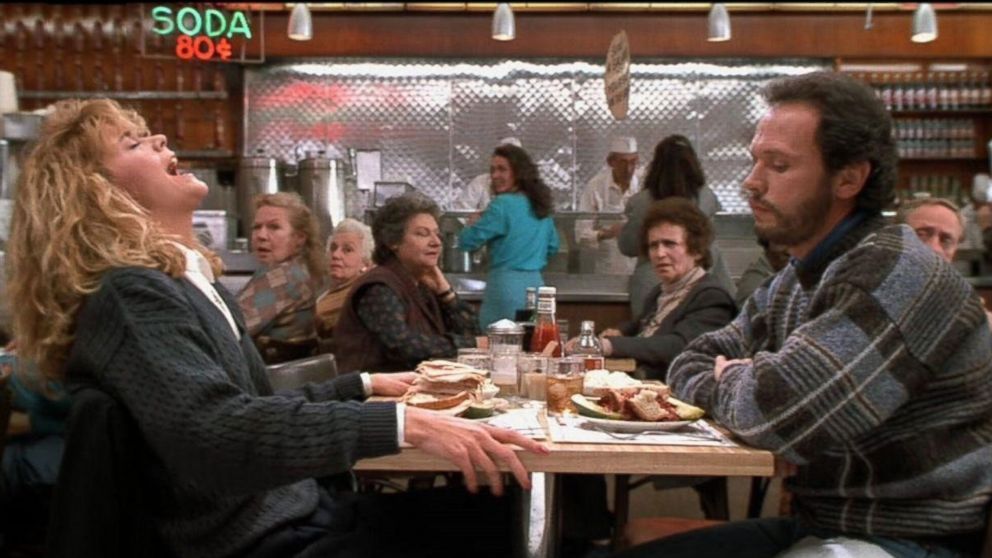
A candid therapist of mine once called me the Meg Ryan of grief. You know that scene in the movie When Harry Met Sally, the one in the diner? Meg Ryan’s character, Sally, simulates a full-blown orgasm to prove to Harry that women can easily fake sexual climax if they so choose. The difference between Sally and me was that my grief wasn’t fabricated. It arrived in a tsunami of tears as I did the hard work of ending my first marriage and unraveling the ties that bound my ex-husband and me together.

Birdsong punctuates the steady hum of the insects in the background of the conversation I am having with my mother. The last few days of my staycation became a multi-day mother-daughter sleepover. As we sit on her back porch, I notice that my mother's face is softer now, lightly furrowed like a lovingly plowed field. Still, the criss-cross of tiny lines at the corners of her eyes and mouth cannot hide the beauty that has defined every decade of her nearly 80 years. Despite the signs of her aging, her easy smile and ready engagement in our chatting speak of her continued vitality. I'm glad to see her comfortable in a sleeveless top and shorts on this warm, muggy Indiana day. A few years back she had gotten self conscious about what we joke is the "creeping crepe" of sagging skin and arms that flap more like wings every time you look. She takes good care of herself but there is no stopping the progress of time. These days with her have been fun. We've had several impromptu dance parties, a few walks, a tiny bit of safe shopping, and some great carryout feasts. Together we also listened to educational podcasts, watched a fun documentary about the world famous Puerto Rican astrologer, Walter Mercado, and witnessed Kamala Harris become the first woman person of color candidate for the vice presidency. Mom's trying to make this staycation fun for us because she knows we'd rather be in the mountains and at the beach for a 'real' vacation. To have days of leisurely time with her is precious and if there's anything the pandemic has reminded us, it's that we don't know what's coming next. So appreciating and enjoying the good things we already have in our lives becomes a top priority.

You will not achieve your happiness. Or rather you will not "achieve" your happiness. I’m not saying it’s impossible for you to be happy but that happiness is not an achievement. It is the wholeness and inner peacefulness that is already the natural state of being or Presence , within you. The only thing between you and knowing a deeper sense of joy and contentment with yourself is the thinking mind’s fixed ideas about who you are. These ideas might be positive or negative: I am successful or I am a failure. Either of these beliefs is conditioned on your external circumstances. They rely on the conditions of your bank account or job title or mood state or relationship status or even the contents of the thoughts moving through your mind, in order for you to feel good about yourself. But what if there were something underneath all the judgments of success and failure, good and bad, pleasant and unpleasant? What if you could relax into the abiding wholeness and peacefulness at the very heart of who or what you are? In A Great Wagon , the great Sufi poet and mystic Rumi invites us to enter this space of deeper insight, connection, and wakefulness:
Out beyond ideas of wrongdoing and rightdoing,
there is a field. I’ll meet you there.
When the soul lies down in that grass,
the world is too full to talk about.
Ideas, language, even the phrase “each other”
doesn’t make any sense.
The breeze at dawn has secrets to tell you.
Don’t go back to sleep.
You must ask for what you really want.
Don’t go back to sleep.
People are going back and forth across the doorsill
where the two worlds touch.
The door is round and open.
Don’t go back to sleep. Most people come into see me because they have become entranced by the negative beliefs running through their heads. I ’m not good enough. I am unworthy. I am unlovable. I don’t matter. I am broken. And often at the root of it all, like the three-year-old we once were, we somehow believe I am bad. Such fixed ideas are actually hypnotic trance states or what we most commonly call ordinary waking consciousness or “reality.”
Most of those negative beliefs have their origins in our earliest interpersonal experiences. This is partly why they have such sticking power. But the other reason is that between the ages of two and six our brains are operating in Theta -wave frequency. Theta is the brain wave length of hypnosis. So basically until we’re about seven years old, we are literally in a trance-like state, receiving a big download from our direct experience about how to survive in our families and in our culture. That download programs the software of our perceptions and lays down the tracks of our subconscious and often self-sabotaging mind. Up to age seven or so, children have very little access to critical or rational thinking. They live mostly in the realm of the abstract and their imagination. This is why children are so good at “pretending” in their play. The divide between what is possible and what is real is nearly nonexistent. At this stage, children are much more likely to accept what you tell them: Good children do what they are told. Big boys don’t cry. Nice girls aren’t loud. Your sister is the smart one (or perhaps, the pretty one ). And all of those messages are about as true as the tooth fairy left that quarter under your pillow last night. From this perspective, the process of healing is about getting un-hypnotized from these old, inaccurate beliefs. What we call hypnotherapy is just another way to wake up out of the trance state of our early conditioning and get grounded in the reality of our wise and loving nature. Hypnosis supports us in broadening our state of consciousness so that we can engage in a transformative process of self-inquiry from the perspective of our higher self. For more information on hypnosis, read Hypnosis FAQs .

John sat in the chair practically buzzing. His anxiety was palpable as he described the recent onset of panic whenever he had to audition. As a professional musician, this fear had become quite a hindrance to his career. It was starting to take a toll on his marriage and everyday life as well. “I just don’t understand it,” he says. “I’ve auditioned hundreds of times over the years. Sure, there’s been some anxiety like all performers have but why am I so suddenly terrified now?” His words expressed the mix of fear, despair, anger, and confusion he was so obviously feeling. As I got a better sense of John’s life history, we began to piece together how he grew up with a very demanding, perfectionistic father and a passive but subtly manipulative mother who relied on her son to provide the emotional support she didn’t receive from her husband. John remembered feeling terrified by his father’s judgment and burdened by his mother’s needs. “But even if that’s what’s contributing to my panic, what can I do about it? How do I get rid of it?” he asked somewhat pleadingly. I shared with him how children are often very resilient to trauma in general and especially to these more ordinary or what we call developmental traumas, becoming successful adults in many ways. But, often in midlife like John was, what has been unattended in us or left in the shadows of our psyche will start to emerge in the form of symptoms—anxiety, depression, illness, even a kind of restlessness. These symptoms can be clues that something is not resolved. Something in the past is intruding on our ability to live freely and fully in the present. We talked about how sometimes we have to take a step backward before we can move forward in our lives, and I suggested we incorporate EMDR into the therapy to resolve whatever was underlying his anxiety. Eye Movement Desensitization and Reprocessing (EMDR) is a powerful, evidence-based modality to treat anxiety, acute and post-traumatic stress, phobias, depression, and other concerns. I’ve also used it many times to help resolve complicated grief over the loss of a family member or loved one, or settle inner conflict about a larger life decision like marriage, divorce, or a career change. In our session, I told John that thousands of research studies backed up the efficacy of EMDR, that it was commonly used with military veterans around the world because of its effectiveness and, most importantly, that I had seen over and over again powerful transformation in my clients as they engaged deeply in the process. “Okay, I’m curious,” he replied with a little more hope in his voice. “Let’s do it.” In the next session, I asked him what was the negative belief he was telling himself when he felt the audition anxiety. I’m a failure, he answered promptly. At my invitation, he then began to identify times in his life when he’d had that same or similar thought about himself. Eventually we decided to focus on an old, emotionally charged memory of being a very young boy of five or six years old. He remembered standing alone in his bedroom, practicing his instrument, knowing his father was listening outside the door to make sure he didn’t stop playing until the hour was up. An only child, that little boy wished he could instead play with his friends or even that his father would play games with him like the other fathers he knew. I supported John in accessing the body sensations and feelings he felt in the present as he remembered that old scene. Then I asked him to rate how upset or emotionally charged he felt on a scale from zero to 10. He was surprised by the intensity of something that had happened so long ago. “I’d say it feels like about an 8, when I really tune into the experience.” I reassured him that our work in EMDR would likely bring that down to a zero in the next few sessions. He looked at me skeptically. “Is there really any good reason for you to keep carrying around these old feelings of shame, fear, unworthiness, and anger?” I asked with a slight smile. He smiled back, saying no, obviously not. With EMDR, through gentle, bilateral stimulation of the brain (using eye movements or alternating tactile sensors), we are activating the hippocampus and other key cognitive processing centers, to reprocess emotionally charged experiences that are stuck in a fight-flight-freeze-please survival mode. Unresolved trauma or emotional states can keep us in a kind of trance, which keeps our body and brain looping through the same set of thoughts, feelings, and reactions, even though our conscious mind can assess that there is no danger present or knows that we are adults now, not the disempowered, dependent child we once were. Through EMDR, we don’t erase or eliminate these memorized and painful emotional states. Instead we transform our relationship to them by supporting the body-mind to complete the cycle of activation and repair that didn’t happen at the time of the experience, allowing us to return to our more natural state of homeostasis and calm. When we can process through those experiences in a new way, our fully adult, more empowered self is back in charge. The past is now in the past. And we embody all the resources we actually have as adults: our ability to make choices, express our feelings and needs, and enjoy intimate connection with others. In the reprocessing sessions, John began to acknowledge, express, and honor the feelings and needs he had as a young boy and of his inner child today. He brought the inner resources of his adult self—compassion, protection, love, and choice—to shift his whole experience of that younger, disempowered state. Finally he could meet the needs of his child self wholeheartedly, without limitation or reservation. As he healed the old rift within himself, he was surprised to find that feelings of deeper compassion for his deceased father’s emotional wounds also emerged. “I hated and feared that man for years,” John reflected, “but now I can see how his own trauma, especially as an immigrant who had experienced many losses, made him the way he was. I feel a sort of tenderness now not only for what I missed out on in our relationship, but also for what my father missed. It feels good to let go of that old resentment and fear.” At our next session, I was the one surprised. John had always been very tense and fidgety in our meetings. His anxiety had been so high before he came to see me that he had nearly been hospitalized. It often felt like he was about to jump out of his skin. But that day, he came in smiling. He sat in the chair, radiating a kind of calm that was now as palpable as his anxiety had been. He shared with me his excitement that he had recently auditioned beautifully without anxiety for two orchestral opportunities. His wife was astonished at the change in him and they had begun to connect at a deeper level. We celebrated his healing and the courage it took for him to trust his ability to journey into the heart of his pain in order to find the freedom he didn’t think was possible.

Hypnosis FAQs The natural healing force within each one of us is the greatest force in getting well. —Hippocrates People tend to have a lot of preconceived notions of what hypnosis is. Here are a few facts and some myth-busters to help you explore how hypnotherapy might be valuable to your own journey of transformation. What is hypnosis? Have you ever gotten so absorbed in reading a book, watching a movie, or playing a game that you didn’t notice how much time had passed or what was going on around you? Or perhaps you have driven somewhere and then realized you were so focused on your thoughts that you didn’t pay attention to how you got there? If so, you’ve experienced an altered state of consciousness similar to what happens in hypnosis. We also may commonly tap into altered brainwave states in meditation or guided imagery, while spending time in nature or during physical exercise, or any other experience where we are able to enter a flow state of relaxed concentration. The primary intent of hypnotherapy is to help you gain more control over your behavior, emotions, or physical condition. When you are in a hypnotic state, your attention is more focused. You are relaxed and calm, and more receptive to healing processes and positive suggestions that you determine will support your therapeutic goals. Why use hypnosis? In hypnosis, we can learn to listen with more clarity and openness to the wisdom of our inner healer or more authentic self. It is one of the oldest and best-known forms of mind-body medicine. Clinical hypnosis, also known as hypnotherapy, is a scientifically proven method creating positive change. With hypnosis, for example, you are able to take better advantage of the mind’s ability to control the body’s response. Adults and children in many clinical settings learn to use it as part of their overall treatment for pain, headache, nausea, anxiety, depression, needle or other phobias, skin disorders, and other physical concerns. Clinical research likewise demonstrates significant improvement in surgical recovery and survival rates in persons who use hypnosis to support their healing. Hypnosis can also help you to move out of the “trance” of negative thinking and habitual choices. For example, you may think, “I’m not going to eat that donut” and then find yourself taking a bite. It’s as if part of you is saying, “Yes, I’m going to change” and another part says, “No way am I changing!” Hypnosis helps you to access your own resources in resolving the conflict between these parts so that you can make more empowered choices that truly benefit you. Who can learn hypnosis? Almost everyone can learn to guide themselves into a hypnotic state, but some people seem to have a stronger native talent for hypnosis that may allow them to benefit more easily. In the actual process, the therapist will support you in using imagery and your imagination to strengthen your hypnotic ability and to address treatment goals. Using hypnosis for change is like learning any other skill, the more you practice, the more you benefit from that practice. And with practice, most of us are able to use hypnosis favorably if we are highly motivated to address the problem. Of course, like any therapeutic approach, not everyone can achieve the results they want with hypnosis. Myths about hypnosis Portrayals of hypnosis in the media or by stage performers lead to many inaccurate assumptions about hypnosis: Myth 1: I’ll lose control or say or do something stupid in hypnosis. People often fear that they will lose control of themselves or be controlled by the hypnotist. During hypnosis, you are in full control at all times. In fact, the active participation of your will power and imagination is crucial for you to achieve your goals. The therapist’s role is to act as a guide and coach, and you are always free to ignore or disregard any suggestion made to you. No patients will be hypnotized without their informed consent. Myth 2: I’ll fall asleep in hypnosis. Although the Greek word hypnos refers to sleep, hypnosis is not a sleep state. In addition to other observable differences, science has been able to distinguish hypnosis from sleep. EEG studies show that brain waves in hypnosis have a high level of alpha activity, indicating alertness, whereas the brain waves of sleep have little alpha activity. PET scans also show that hypnosis produces a very specific pattern of brain activity not present during sleep. Myth 3: I’ll lose consciousness in hypnosis and won’t remember the experience. While spontaneous amnesia following a very deep hypnotic trance is possible, it is rare. The vast majority of people work in a medium depth trance to accomplish their goals, which allows them to remember everything that happens during their hypnotic experience. Myth 4: I’ll get stuck in hypnosis. Remember that during hypnosis you are not asleep and you do not lose your free will. You can be conscious of everything around you, alert and awake. Your autonomic responses may be slowed during hypnosis, but your mental awareness remains acute. When the session is over, the therapist will gently instruct you to return to ordinary consciousness. If you need to come out of hypnosis for any reason, you will readily do so. Myth 5: Hypnosis is a supernatural or “spiritual” phenomenon. The American Medical Association has recognized hypnosis for decades as a safe and effective tool for creating symptom relief and deeper positive change. While hypnotic trance has been used for spiritual purposes, nothing about hypnosis is particularly “spiritual.” The experience of hypnosis is a natural, relaxing one. To read more about the use of therapeutic hypnosis in my practice, enjoy the blog Get Un-Hypnotized .

Eight years have passed since my website photo was taken. It feels like lifetimes ago. It probably feels that way to you too. So much has changed. Some days it's almost impossible to calculate what's been gained and what's been lost. Life is not a zero-sum game, however, so I mostly count the blessings of love and gratitude in my heart as the greatest legacy of this passing time.

So how do we clear the field? What can help us to defuse these belief bombs that threaten our sense of security and value? Where is the rich compost from which we can nurture the insight needed to transform our relationship to self and others? Who can guide us in rediscovering our natural wisdom and warmth? Nearly two thousand years ago Tibetan practitioners of Buddhist Tantra devised a powerful visualization practice known as The Jewel Tree or Healing Mentor meditation as one answer to these questions. To this day, monastics and lay persons take themselves through a series of steps to invoke a personally transformative relationship with their mentor or teacher, that is ultimately about healing themselves and, on that basis, healing the world. "Deep personal and social transformation only happens in an interactive field of love. And the more we plow that field, learning to love ourselves and others with unreserved openness, the more we align ourselves with the vitality, passion, and purpose of the consciousness that wants to live uniquely through each of us." The basic steps involve dissolving the ordinary sense of ourselves and the world as we experience it. We then create in our imagination what Buddhist scholar Robert Thurman likes to call an ideal "buddhaverse" or mandala inhabited not only by a personal mentor or teacher, but also by a limitless number of awakened beings who also join us to offer their insight and caring concern for our wellbeing. We allow ourselves to bathe in this unconditionally loving and enlightened attention, not only from our personal mentor but also from all those who embody the qualities we want to cultivate in ourselves: wisdom, lovingkindness, courage, devotion, and so on. In the practice, the loving relationship with our mentor transmutes our ordinary, neurotic, and habitual ways of seeing and reacting to our experience. This deepening connection with the mentor creates a super-charged field of wisdom and compassion that allows us to feel safe enough to acknowledge our flaws without shame, and to recognize the already present wakefulness inside of us that is just like the mentor's. The practice thus begins to reveal and stabilize our bond with our own enlightened nature. From that basis, we activate our unique capacities to bring whatever insight and compassion we have gained to help others' healing and ultimately to transform our world. So you can see that even these ancient monks and lay people were dealing with the same issues we are! They drew on their intuition and creativity, using positive affirmations and visualization to manifest a better version of themselves and the world. In many ways the mentor represents the wise, all-loving parent we never had, and helps to heal the attachment wounds of our upbringing that keep us walled off from the truth of our basic nature—which is open and loving—and of our inseparable connection with others. Deep personal and social transformation only happens in an interactive field of love. And the more we plow that field, learning to love ourselves and others with unreserved openness, the more we align ourselves with the vitality, passion, and purpose of the consciousness that wants to live uniquely through each of us. These days we tend to think of positive affirmations and guided imagery as modern technologies for learning to love and care for ourselves. But the truth is these kinds of powerfully transformational practices have been around for as long as humans have been seeking to heal a sense of separation between themselves and the nature of reality itself. This genuine—sometimes tender, sometimes fierce—longing to repair the perceived rupture between ourselves and our own awakened nature has compelled our oh-so-human species to invent a multitude of ways to cultivate our connection with unconditional love. Our hearts somehow know that nothing less than direct contact with the spiritual nature of all things, including ourselves, will satisfy this longing and allow us to be transformed in and by this loving and living relationship with the divine. * * * I've been working with this practice over the past six months as a support to my own transformation, and as part of my study in contemplative psychotherapy with the Nalanda Institute for Contemplative Studies . My most sincere gratitude goes out to Joe Loizzo, Fiona Brandon, Miles Neale, Pilar Jennings, Emily Wolf, and all my fellow students, each of whom have been important mentors for me this year. If you'd like to try a version of this meditation, I've recorded one for you. Click here to access and download it at your leisure. Let me know how it supports your own growth and change!

When I was 19 years old, I volunteered in a shelter run by the Missionaries of Charity in India. Crowded along the banks of the Ganges, this Home for the Dying Destitute housed dozens of residents in the crumbling palace of some maharaja long forgotten. There I met Ajeet. Ajeet had once been a poor but promising student at university. Eventually he worked in the civil service where he imagined a bright future for himself. Then tuberculosis struck. He lost his job and a long series of unfavorable events left him begging on the streets. When I met this cheerful and resolute man, the nuns had tended him for several months, helping him to regain some of his strength. He became an unofficial supervisor of the daily tasks I was set to. One day I commented on his obvious gratitude for these women who had given him a home and a measure of dignity. He acknowledged his thankfulness, then added: “But love is the thing that saves us.” I’ve never forgotten Ajeet but I’ve often forgotten what he taught me that day. Not many of us reading this will face the hardships he did, but all of us will experience some adversity in our lives. Only a single moment stands between us and devastating heartbreak, disability, or death. True adversity, I'm discovering, teaches me that life is precious and that each day could be my last. It reminds me that how I spend my time matters. It demands more discipline, courage, and strength of character than I think I'm capable of. Eventually hard times may even offer an advantage to those of us who survive them: the gift of a certain steadiness in response to life's inevitable ups and downs. The word adversity has its roots in to turn toward, to face, or to confront . Facing our difficulties does not mean that life has to be a joyless, teeth-gritting endeavor. In fact, to hold both the beauty and suffering of our lives in an open handed, open hearted way is rather the point. Turning toward our difficulties with curiosity rather than resistance invites us to accept our experience just as it is—pleasant, unpleasant, or neutral. But this means we have to be willing to confront our attachment to the belief that this is not supposed to happen to me or my life should be different . Loosening the grip on our ideas about how life should be can allow us to enjoy the life we actually have. How we let these beliefs go is part of the practice in mindfulness: again and again we gently guide the mind back to here-and-now awareness. If we let it, our own suffering can break us wide open to the suffering of others. Sometimes the heartbreak of others helps us find the cracks in our own patched together life. That's what Ajeet’s presence did for me. And when he asserted that love is what truly saves, he was teaching me that love is the only thing that redeems our lives from self-centered purposelessness. Ultimately it is in facing the reality of our lives that we uncover a capacity for compassionate connection that is steadier and more spacious. A deeper confidence, even lightheartedness, can emerge as we begin to accept ourselves as we are, rather than as we think we should be. In the rubble and ruins of our imperfect existence, adversity strips away our inauthenticity, and opens the gate to a life more fully lived.New Paragraph

A few weeks ago I was housesitting for friends who live along a river. The river snakes around the edge of the neighborhood, providing sanctuary for eagles and foxes and muskrats. Each morning I would sit on the levee with my tea, watching the water ripple over rocks in the shallows. The chatter of birds and the distant hum of traffic awakened my senses. Streams of thought flowed toward the river as I pondered what I’ve learned over the past several years. One of the primary revelations has been just how much compassion for myself had been missing. I never would have pegged myself as particularly harsh but what I discovered—as I dug through the mud of my inner life—was a driven, perfectionistic, judgmental and impatient gal who was trying her darnedest to get distance from a deeper pain. That gal was also fairly demanding of others, in subtle ways, wanting to be right much of the time and wanting life to conform to her needs to feel safe and valued. Part of my newly emerging self-compassion is to recognize that this is the human condition. We want to feel secure and loved. We develop coping mechanisms that uniquely reflect our childhood conditioning and individual temperament. We want the “rightness” of our point of view and the “necessity” of our wants validated. At an intellectual level, I’ve known that all along. But lately hard knocks and hours of therapy have brought that knowing into my bones. And that’s another thing I’m having compassion for: we can’t get there until we get there . A deeper level of self-insight only comes when we are ready. And so we can be patient and kind with ourselves, trusting that everything comes at the right time for our spiritual and psychological awakening. Buddhism talks of maitri . From the Sanskrit it is a view toward changing our relationship with pain and difficulty: "It means unlimited friendliness toward ourselves, with the clear implication that this leads naturally to unlimited friendliness toward others. Maitri also has the meaning of trusting oneself—trusting that we have what it takes to know ourselves thoroughly and completely without feeling hopeless, without turning against ourselves because of what we see." —Pema Chödrön Or as Thich Nhat Hanh says, maitri is the intention and capacity to offer joy and happiness, so by deduction we have to start with ourselves. You are probably familiar with the story about the Dalai Lama and maitri ? When queried many years ago by a Western practitioner about the topic of self-hatred, he was befuddled: “What is self-hatred?” The concept was so foreign to him that he couldn’t begin to fathom this common experience of personal shame and self-loathing that many Westerners feel. We suffer when we don't feel connected with our basic capacity for self-oriented lovingkindness. This is particularly true in societies like ours where not being enough and not having enough drive the spend-and-acquire economy. It’s been a long, winding journey to be tender with myself, even to be tender with my tendency to beat myself up. When I was on retreat a few years ago, I had an interview with one of the teachers. We sat across from each other on our cushions without speaking. She looked at me intently. Then she calmly said, “Dina, I really encourage you to practice maitri.” It took me three years to understand what she had intuited but I am joyful now to dip my feet into this river of compassion and feel its cooling, calming effect on me and, with luck, on everyone around me. For a lovely and good-humored five-minute teaching on maitri by Pema, click here . Photo Credit: Dan Axler

